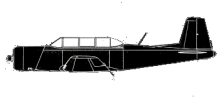
ASN Wikibase Occurrence # 72411
This information is added by users of ASN. Neither ASN nor the Flight Safety Foundation are responsible for the completeness or correctness of this information.
If you feel this information is incomplete or incorrect, you can submit corrected information.
| Date: | Sunday 7 February 2010 |
| Time: | 08:40 |
| Type: |  Nanchang CJ-6A (Yak-18A) |
| Owner/operator: | Private |
| Registration: | N6263D |
| MSN: | 4732023 |
| Total airframe hrs: | 2339 hours |
| Fatalities: | Fatalities: 0 / Occupants: 2 |
| Aircraft damage: | Substantial |
| Category: | Accident |
| Location: | Red Mountain Park, Mesa, AZ -
 United States of America United States of America
|
| Phase: | Taxi |
| Nature: | Private |
| Departure airport: | Falcon Field, AZ (FFZ) |
| Falcon Field, AZ (FFZ) | |
| Investigating agency: | NTSB |
| Confidence Rating: |
The pilot reported that about 30 minutes into the 45 minute-long flight, the engine began vibrating and he maneuvered the airplane back towards the airport. As the airplane joined the downwind leg of the traffic pattern, the pilot heard a "bang," followed by the engine experiencing complete loss of engine power. Unable to land at the airport due to altitude loss, the pilot performed a forced landing in an adjacent park. During the landing sequence the airplane struck a building while the pilot attempted to avoid a pedestrian. The airplane sustained substantial damage to the right wing and forward fuselage. Examination of the radial engine revealed that one of the cylinder heads and its associated piston had become separated. The remaining internal sections of the engine sustained catastrophic damage, consistent with continued rotation after the failure of the cylinder. Half of the studs attaching the failed cylinder to the head exhibited fatigue signatures consistent with insufficient clamping pressure applied to their nuts. A full service history for the engine was not located; however, maintenance records indicated that the cylinder head had not been removed in the 11 years and 317 flight hours prior to the accident.
Probable Cause: Separation of the cylinder from the engine during cruise flight due to fatigue in the studs attaching it to the engine casing.
Accident investigation:
 |
|
Sources:
NTSB
Location
Revision history:
| Date/time | Contributor | Updates |
|---|---|---|
| 07-Feb-2010 19:44 | RobertMB | Added |
| 24-May-2010 22:14 | Anon. | Updated [Narrative] |
| 10-Mar-2011 11:21 | TB | Updated [Aircraft type, Source] |
| 21-Dec-2016 19:25 | ASN Update Bot | Updated [Time, Damage, Category, Investigating agency] |
| 26-Nov-2017 15:23 | ASN Update Bot | Updated [Operator, Other fatalities, Departure airport, Destination airport, Source, Narrative] |
Corrections or additions? ... Edit this accident description
The Aviation Safety Network is an exclusive service provided by:


 ©2024 Flight Safety Foundation
©2024 Flight Safety Foundation